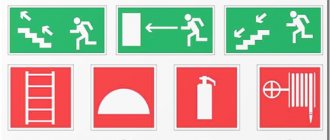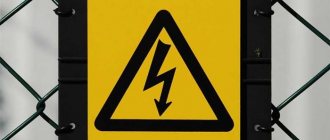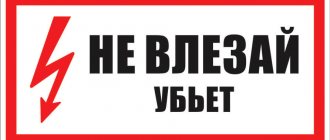Any maintenance and repair of electrical networks, as well as equipment and machinery that consume electricity, require compliance with measures to ensure human safety from electric shock. This is exactly what electrical safety posters and signs are designed for. They inform a person about the prohibition of certain actions with electrical installations, approaching dangerous areas, as well as about carrying out preventive and repair work. The use of these products, which ensure electrical safety, is regulated by GOSTs and operating standards for electrical installations.
In simple terms, electrical safety signs are various signs and inscriptions that notify people that there is a danger of electric shock. In this case, touching switches, buttons and other switching devices is strictly prohibited, as well as performing other actions dangerous to one’s own life and the lives of other people. In this article we will sequentially consider the following issues: types and types of electrical safety signs and posters, areas of their application and some features of such products.
Product classification
According to the nature of their use, signs and inscriptions to ensure safety during operation and maintenance of electrical installations are divided into portable and stationary. Portable ones are used for the duration of certain work, and stationary ones are used for permanent use in a specific place. Depending on the functionality of the application, posters and safety signs are divided into the following four types.
- Prohibiting. Designed to prohibit any actions with switching devices, the inclusion of which could endanger the lives of people, and also prohibit work without protective equipment inside certain objects under certain conditions.
- Warning. Inform staff or third-party visitors about the danger of electric shock when approaching current-carrying elements of electrical equipment, equipment or electrical networks that are under voltage dangerous to human life.
- Prescriptive. They allow preventive and repair work to be carried out at a specific location of electrical installations in compliance with occupational safety requirements, and also indicate a safe approach to this work area.
- Index marks. Indicate the placement of various devices that impose additional requirements for electrical safety. When prohibiting and warning posters are used simultaneously, safety signs are placed on top.
Below we will look at plates, inscriptions, signs and posters on electrical safety of each type separately, with a description of installation locations and other features of use.
Poster Conductor Sections
Electrical safety poster. Sections of Provodnikov-3
The poster shows the cross-sections of phase conductors, neutral wires, and protective conductors. For example, the cross-section of the phase conductor (and, naturally, the neutral one, because no one has canceled Kirchhoff’s first law) in power and lighting networks must be at least 1.5 mm². This is also in the PUE, but for those who like to connect additional sockets with 0.75 mm² wiring, it will be more clear on the poster.
The cross-section of the protective conductor PE in a single-phase network must be equal to the cross-section of the phase conductor. And in three-phase it may be less.
Prohibiting
The very name of such posters determines their main goal - this is to impose a ban on any manipulations with switching devices (switches, circuit breakers, etc.), so that when carrying out electrical work, someone does not accidentally supply electricity to the power supply network of an electrical installation. Let's look at each of the prohibition signs in order.
- The sign indicates an area where there is a strong electric field that is dangerous to life. Passage through such an area without special protective equipment is strictly prohibited. A sign is installed on open switchgears (OSD) with a voltage of more than 330 kV and an electric field strength of more than 15 kV/meter. Placement of the poster: fencing the area at a height of at least 1.8 meters.
- The poster is hung on switching devices such as switches, buttons, keys and so on. The sign prohibits the supply of voltage until maintenance or repair work is completed. If there are no switching elements, the poster is installed near the removed fuses. Used to ensure electrical safety in electrical installations with voltages up to 1 kV and higher.
- The functions and installation locations of this poster are no different from the previous safety sign. Area of use: underground cable and open overhead lines for supplying electrical energy, on which preventive or repair work is carried out. The poster prohibits any manipulation of switching devices until the work is completed and the poster is removed.
- This prohibitory poster is hung on keys that are designed to control switches on high-voltage lines (VL). Functionally, the sign establishes a ban on erroneously manually turning on the power of a high-voltage power line while maintenance or repair work is being carried out on it, which could lead to electric shock to people.
The entire above list of electrical safety signs is prohibitive, as it prohibits certain actions. Posters can be either portable or stationary, installed on a permanent basis.
Do not turn on! People working
Plate code:
SES01
Plate type:
prohibition sign
Installation locations:
The sign is posted on electrical installations up to and above 1000 Volts. They are hung on the drives of disconnectors and load switches, on keys and remote control buttons, on switching equipment up to 1000 V, which, if switched on incorrectly, can supply voltage to the workplace. For connections up to 1000 V that do not have switching devices in the circuit, the poster is hung near the removed fuses.
Plaque placement:
to the oil switch control key (Fig. 1) and to the removed fuse blocks (Fig. 2).
Rice. 1. Portable sign on the oil switch control key
Rice. 2. A portable sign is placed on the removed fuse blocks
Design:
· flat;
· voluminous.
Sign material:
self-adhesive film, PVC plastic, galvanized metal, composite. The image on the signs is applied using solvent printing technology with paints that are resistant to environmental influences.
Surface types:
· photoluminescent (Fig. 3);
· Reflective.
Rice. 3. Photoluminescent sign
Durability requirements:
1) mechanically strong, without deformation (deflection) when placing and removing a load of 0.2 kgf/2 min;
2) the surface is smooth, uniform, without inclusions;
3) resistant to alkalis, fuels and lubricants, detergents, water, solar radiation, acids according to the parameters of GOST 9.403;
4) heat- and cold-resistant; climatic version for outdoor placement no less than cat. 1, UHL (from minus 40 to plus 60 °C), and under these conditions bubbles, peeling, and cracks should not form.
Dimensions of the plate according to GOST
SES01 plate shape parameters:
1) GOST 12.4.026-2015
:
· geometric shape - square, rectangle;
· clause 6.3.3.7 indicates that the smaller side of the rectangle is related to the larger one as 2:1. Edge width - 0.025 of the smaller side, cm; border width - 0.025 of the larger side, cm;
· clause 6.3.4.1 contains the formula for height (equal to the vertical side):
,
where L is the identification distance;
Z - distance factor (40, 65, 25 at illumination, respectively, 150–300, 300–500, 30–150 lux);
2) the average size under normal lighting, standard Z = 40 and L = 25 is in the table. 3 GOST 12.4.026-2015
;
3) permissible deviations and corner roundings GOST 12.4.026-2015
:
· clause 6.3.4.7 recommends a permissible deviation of ±2%;
· clause 6.3.4.8 allows rounding of corners (for squares the radius is 0.04 sides, for rectangles - 0.02 smaller sides);
4) signs with a reflective coating and photoluminescence must be no less than 125% of the average dimensions. Designs with illumination over 500 lux are more visible, so for them the identification distance is doubled, and the size can be halved.
Example
What is indicated on the plate
The SES01 plate is marked with the words “DO NOT TURN ON! People are working."
Warning
Safety warning posters are designed to inform people when approaching areas or equipment where the possibility of electrical shock exists. The following signs belong to this type of information signs.
- A poster with this inscription is posted at the site where testing work is carried out for electrical installations under high voltage. The work site has a special fence on which this safety sign is installed.
- Notifies personnel and bystanders about the possibility of electric shock to a person when touching current-carrying elements of equipment or electrical networks that are powered by life-threatening voltage.
- This sign warns of the presence of dangerous voltage on various electrical installations and equipment. It is the most common of all electrical safety warning posters.
- Triangular safety sign for permanent placement. It is installed on the doors of various power supply facilities and warns of the presence of voltage that is dangerous to human life.
All warning signs and electrical safety posters can be stationary or portable, as well as prohibitory ones.
Warning posters and signs
These safety features were developed by GOST and have their own numbering indicated in the appendix:
- 5. Triangular yellow sign with a zigzag arrow pointing downwards. Has a black frame.
- 6. Monochrome sign with an arrow. Apply permanent paint to various fences, poles, concrete slabs, etc.
- 7. A poster warning of dangerous approach to an electrical installation. It has standard dimensions of 300*150 mm. It is made with a bright red frame and an arrow pointing down, as well as black letters on a white background. It can be installed on temporary fences, passages, as well as in other places where access is dangerous due to electric shock.
- 8. Poster warning about testing and inspection of electrical equipment/installations.
- 9. Warns personnel about the threat to life when ascending to a high altitude zone. For example, when a nearby structure is under high voltage.
There are also posters numbered 10. They are printed in red letters, bordered by a standard red frame and white border. Such devices are installed in places with high voltage.
Prescriptive
This type of inscriptions and signs indicates a clearly defined location for a set of repair and maintenance work in various electrical installation systems, as well as completely safe approaches to this equipment. The following posters are included with these electrical safety products.
- This poster indicates to personnel and interested parties where preventive and repair work on electrical installations and equipment is to be carried out. Installed directly at the work site.
- This sign informs personnel of the safest route to access when carrying out any work on electrical equipment. Most often installed in passages and on stairs.
Prescriptive signs are usually used in the construction of various energy supply system facilities.
Poster Formation of grounding systems
Electrical safety poster. Formation of Grounding Systems-4
The most informative poster. Half of the PUE is outlined here. Anyone who studies this poster will have 99% of questions about electrical wiring eliminated.
Let me remind you once again that posters do not replace, but complement the PUE and other normative and educational literature.
And how to print such posters on several A4 sheets - I described in detail in the article about how to print a large diagram or drawing, or a poster.
Pointing
This category of safety signs includes only one poster, with the inscription “grounded”. It indicates that this electrical equipment is connected to a grounding conductor and it is strictly prohibited to supply power to it from power supply systems.
We have reviewed almost all the posters, signs and inscriptions that are used to ensure human safety when carrying out various work on electrical installations. Below we will provide information about the features of the manufacture and use of these products, which provide protection to people from electric shock.
Tough as it is. Soviet safety posters with comments (43 photos)
Author: Panda
31 August 2022 10:34
Tags: Labor protection USSR safety posters
25020
43
...in some places these are just posters for horror films, in others they are examples of the artist’s crookedness. But overall it's tough. In no case do I consider the posters useless; of course, this saved me from injury and even death, but the execution does not leave anyone indifferent when viewed in an abstract manner. Of course it’s a bastard, but every time I watch it, I smile.
1.
0
See all photos in the gallery
Zyuzga tore me apart. And the main expression on the zyuzga operator’s face is: “Fuck off...” Maybe he was molesting his wife, I don’t know, but when going out to the pier, make sure that there is no zyuzga on her. But in addition to the zuzga, there are also pins, roller necks, ruffles and a fender with buffers. But, in my opinion, first place should be given to “Don’t Walk on the Fish” (...otherwise you’ll end up with zyuzga)
2.
0
I'm sobbing. And below is a Spiderman glove. That's it, dude got it. Now someone will be responsible for the fish. And the guy is so harmful, judging by the expression on his proletarian face. He deliberately steps right on the herring, although he could have walked between them. (In general, it is better for children and pregnant women not to get involved)
×
3.
0
“Mother, you’re crazy!!!” And Tsapka is apparently a hoe. I wonder what year the poster is.
4.
0
Be careful with the shovel, you sleeping, drunk, mustachioed fuck. Finally, in my opinion, this is Taras Bulba, and he fell asleep but continues to throw coal onto the conveyor. You're in the mouth! No, you have to watch where you’re putting your face. In the background there’s another one with blood on his face, apparently he’s already raked it off earlier and, pay attention, those blue silhouettes are very reminiscent of the insidious Zyuzga. I DO NOT see a poster with a rake.
5.
0
I'm really curious, what is that white crap on the roof? And if such a poster was hung somewhere at the exit to the roof, I would definitely get distracted and stumble.
6.
0
I have a strong association with boobs. So my hands reach out to finish the rest. The main thing is that people are surprised that the instruction sheet is empty. A setup, or, as they said in the days of the NKVD, sabotage! I think in revenge for sticking my fingers somewhere else. Serves it right.
7.
0
Itit. Sergei Bubka in a jump. Finally, the tin is unreal. The art maniac and the transmission shaft wish everyone a good day at work. And it’s not without reason that this poster was invented. It's p..... simple.
8.
0
Yeah, don't button your pants either. Really, what an idiot you have to be to become a character in this propaganda. There’s no point in yelling, you have to think with your head. I figured out how many different mechanical devices were produced in Soviet production, and how many posters were needed for the idiots. (some comments confirm that if a person is a fool, then no poster can fix this. For such people, you need to hang everything with them. Be careful on the steps! The knife is sharp! The soldering iron is hot. Beware of the car! and so on...)
9.
0
In short...there's a match here with a moonshine still. As if “Beware of the safety valve” and don’t care what pressure there is in the system.
10.
0
It was only later that the hose acquired a masculine gender, but at first it was an untied hose. Cunning like all women. The hose is a nuisance and a relative of the tack. They say it is still rampant.
11.
0
Aaaaaaah...everything is correct, but for some reason I smiled about the careful accounting. Although it is clear why it is necessary to count.
12.
0
...and when they are stolen. Here we see Superman before the start. The current cape is missing. In my youth I flew like hell with wires, everything is clear here, but the execution of the poster... I can’t help but smile.
13.
0
That's it, you damn rascal... The nail will hit the head and there will be a hole in the cap. By the way, an investigator from the NKVD came to see who secured the hose so poorly.
14.
0
And the man with the ax is calm, as if he turns out the lights like that three times a day.
15.
0
Oh, this is about those who clean the roofs of snow. The main thing is not to fly faster than your hammer.
16.
0
JJozzo? No, well, Semyon Semyonich. At least I could shut it up with corn, or something...
17.
0
This is some kind of Ukrainian machine, because it doesn’t work without lard. And look what the intelligentsia is like. She doesn’t eat lard with her hands, give her a fork. Moreover, bypassing the mouth directly into the neck... back and forth. And then some garlic after that.
18.
0
Sergey Bubka - second attempt. Is it really difficult to cover the ends of the shaft with something, and there will be no need for posters?
19.
0
Nashaalnika, don’t put out the electric motor from the crusher mana. And don't set the engine on fire, you rascal. I saw burning motors...at the time when I worked as an electrician on duty at an AYA.
20.
0
But this is in vain. Let him check it once. You also need to use different hands so that the current passes through the heart at once. The more idiots who are electrocuted, the safer it will be at work. Otherwise, such a Dzhamshut will then put the lard into the neck without a fork, or with a zyuzga it will crawl under the transmission shaft. This is worse than wandering around the workshop with an unattached hose. I remembered who he reminds me of. Jimmy Carrey.
21.
0
I'm sitting wondering if this is a werewolf or a mutant rat? It’s dangerous to put the workpiece into the press without tweezers. And the rat in overalls with such b…. Is it dangerous to use tweezers? You don't have Van Helsing, you've bred parasites. If only she didn’t smell the lard in her neck, otherwise “Resident Evil 5” would start to be a mess.
22.
0
Razyava. You're lucky that it's not a bottle of acid, but bricks. It would be like in Hellraiser 3.
23.
0
Well, that's all good. Now the mutant rat will smell blood and will use tweezers for him. Of course it was all that crap. The guy had probably never seen it either and was curious. A good unit for a horror movie. “Alone in the Shop 2 or Blood on the Fan” Starring Pankratov-Cherny. Although it is possible that he opened the beer about this, it was not said what kind of lids he was talking about.
24.
0
Pralna. It was necessary to use your hand. No, I absolutely don’t understand how one can become the hero of such a poster.
25.
0
Well, this is an obvious sabotage. They zazhivodirovali shop managers and went to camps for 15 years. Nothing!!! do not leave it unfortified. It was necessary to nail it with a hammer to the floors, yeah.
26.
0
Are you hungover so that your hands don’t tremble when you turn a bolt? I knew several men who could not work without a hundred grams.
27.
0
This is tough! I was drinking at work. For this I was beaten and doused with blue ink. Comrades' court is the most cruel court in the world! This is how the Soviet worker should be represented.
28.
0
...and with a flat one you can fall as much as you like. And please note that the hammer is not secured to the flats.
29.
0
-Uh, macaw, you are not a good person. Why did he stab me with a pitchfork? -I'm sorry, comrade. One thing confuses me. Why are they both up to their ears in blood?
30.
0
Unexpectedly right? Apparently the guys have their first casting. They didn’t know that liquid metal was really liquid.
31.
0
As I understand it, we are talking about buffers of size four and up, at least. As far as I remember, the coupling buffer on the car is at waist level, not higher. Here you are either a dwarf or the harsh mutant Chelyabinsk carriages.
32.
0
What a neat guy. You can also change the wheels of a car while moving, or the propeller of the icebreaker “Lenin”. If this is his first watch with this device, then he’s obviously an idiot. It’s strange that when he was allowed to work on that first day, he was simply not instructed.
33.
0
...You understand this in labor class at school and remember it for the rest of your life.
34.
0
Well, it's not a horror movie, it's more of a comedy. In the circus arena, gymnasts are tightrope walkers. And the shadow lags behind the stairs. The Matrix...
35.
0
...slings and various other crap. And don’t stand below the arrow.
36.
0
And below for others there is a sign “When removing the anchor, beware of the fender” or something like that... the fender looks too impressive.
37.
0
Aaaaaaaaaaaaaaaaaaaaaaaaaaaa!!! No, it's creepy. We remember the poster about electricity: “If you can’t separate the woman from the drilling machine, use an axe...” Although it’s unlikely that anyone will have time.
38.
0
I'm skating here. Just a hell of a lot :))) And the facial expression is like “Ha... good job.” In principle, this poster could have been anywhere.
39.
0
We hang this in the hold and under the roofs from where the hammers fall, and also under the roofs, because from there, if not a worker is about to come up, then a stack of bricks for sure.
40.
0
Sooooooo...even when you need to change the drive belt, or wipe it. We’ll just hang a second sign next to it for safety.
41.
0
Benny Hill is resting. Sobsna, like Vitsyn with a pot in Operation Y
42.
0
Here! She is a slender, pretty chemist, everything about her is clearly legible and large. She’s a good woman, the main thing is that she doesn’t mix up the jars and plug them with corks.
43.
0
And in general, working is harmful. It’s not even an hour that the fender will whistle past, or some kind of horse with 20 liters of sulfuric acid on its back will collapse. In other words, it was a harsh time. EU regulations were not yet in effect, so mutant rats walked around the workshops with tweezers and deftly removed the fat from the fork right at their open necks. Yes. Apparently there have always been plenty of idiots everywhere. You can draw a thousand more posters for them, about a sharp knife, about a heavy crowbar, about steps on a ladder, about a flame in a stove, a hot soldering iron and a very hot gas welding...
Source:
Related links:
- 70 years of the nuclear shield: how the first tests of the Soviet atomic bomb took place
- 20 motivational posters that taught intelligence to Soviet children
- Krasnoyarsk artist turned Soviet cartoon characters into action heroes
- “Rare Beast”: American military took a ride on Soviet T-80 tanks
- The Ministry of Defense showed firing from the most powerful mortar in the world
Tags: Labor protection USSR safety posters
ANTI-FISH All about politics in the world
Do you like to remember how things were before? Join us, let's feel nostalgic together:
175 97 78
Liked
78 7
103
Partner news
Features of manufacturing electrical safety signs
All information products intended to ensure electrical safety must be made of dielectric materials. Metal can only be used for products that are located away from parts of equipment and electrical installations that are under voltage that is dangerous to humans. Signs of permanent use (stationary), to be placed on concrete and metal structural elements of buildings and equipment, can be applied with special durable paints using stencils or using products based on self-adhesive film. At night, all electrical safety posters and signs must be illuminated.
Full list of posters for the first part:
The second part is here.
- Fittings of Vessels-2 – Safety Poster.jpg
- Cylinder Gas Supply-3 – Safety Poster.jpg
- Petrol Saw-1 – Safety Poster.jpg
- Gasoline Saw-2 – Safety Poster.jpg
- Petrol Saw-3 – Safety Poster.jpg
- Explosion Fire Safety-1 – Safety Poster.jpg
- Explosion Fire Safety-4 – Safety Poster.jpg
- Explosion Fire Safety-5 – Safety Poster.jpg
- External Lighting Devices_Steering Control-2 – Safety Poster.jpg
- Sling-1 Selection – Safety Poster.jpg
- Gas Welding-3 – Safety Poster.jpg
- Gas Cylinders-1 – Safety Poster.jpg
- Gas Cylinders-2 – Safety Poster.jpg
- Gas Cylinders-3 – Safety Poster.jpg
- Details Equipment Timber-3 – Safety Poster.jpg
- Chiseling Drilling-3 – Safety Poster.jpg
- Road Marking Vertical-1 – Safety Poster.jpg
- Road Marking Horizontal-1 – Safety Poster.jpg
- Arc Welding with Covered Electrodes-1 – Safety Poster.jpg
- Arc Welding with Covered Electrodes-2 – Safety Poster.jpg
- Arc Welding with Covered Electrodes-3 – Safety Poster.jpg
- Reinforced Concrete Structures-4 – Safety Poster.jpg
- Protective Equalization-2 – Safety Poster.jpg
- Protective Equipment-1 – Safety Poster.jpg
- Sign Alarm-3 – Safety Poster.jpg
- Classification of Grounding Systems-1 – Safety Poster.jpg
- Wheels Tires Engine-3 – Safety poster.jpg
- Computer Safety-1 – Safety Poster.jpg
- Computer and Security-2 – Safety Poster.jpg
- Stairs Certain Types of Work-4 – Safety Poster.jpg
- Metal rolling-2 – Safety poster.jpg
- Harness Engaging Load-2 – Safety Poster.jpg
- General Safety Precautions-1 – Safety Poster.jpg
- Bucket Excavator_Earth Work Safety-1 – Safety Poster.jpg
- Bucket Excavator_Earth Work Safety-2 – Safety Poster.jpg
- Bucket Excavator_Earth Work Safety-3 – Safety Poster.jpg
- Bucket Excavator_Earth Work Safety-4 – Safety Poster.jpg
- Burns Poisoning Frostbite-6 – Safety Poster.jpg
- Danger Zone When Operating Crane-5 – Safety Poster.jpg
- Organization for Electrical Safety-1 – Safety Poster.jpg
- Organization for Electrical Safety-2 – Safety Poster.jpg
- Organization for Electrical Safety-3 – Safety Poster.jpg
- Basic Requirements-1 – Safety Poster.jpg
- Special Conditions-4 – Safety Poster.jpg
- Stop Bleeding-3 – Safety Poster.jpg
- Shutdowns in Electrical Installations with Voltage Above 1000V-1 – Safety Poster.jpg
- Shutdowns in Electrical Installations with Voltage Above 1000V-2 – Safety Poster.jpg
Development of a poster “Electrical safety at home”
MBOU "Vereshchakskaya Secondary School"
Novozybkovsky district, Bryansk region
243015 Bryansk region Novozybkovsky district, Vereshchaki village, st. Kommunisticheskaya 42
Regional scientific conference “Property of the Bryansk region through the eyes of schoolchildren”
Development of a poster “Electrical safety at home”
Authors: Yulia Kuteko and Nadezhda Pylenok, 9th grade students.
Head: teacher of mathematics and physics Shinkorenko M.P.
S. Vereshchaki
2016
annotation
The work “Electrical safety at home” consists of an introduction, the main part, a conclusion and a list of references. The introduction outlines the problem and its rationale. The main part of the work contains an explanation of the causes of electrical injuries in everyday life, introduces the rules for handling electrical appliances and measures to help in case of electric shock. Issues of design and placement of the poster “Electrical safety at home” are also considered.
As a result of work on the project, rules for handling electrical appliances in the house were drawn up; family members of classmates are familiar with these rules; a poster on electrical safety at home was made
- The effect of electric current on living organisms ————————— 6
- Electrical injury ——————————————————————————— 8
- Measures to help in case of electric shock —————————————————- 8
- Main causes of electric shock ———————————————— 9
- Rules for handling household electrical appliances and lamps ——- 10
- Electrical injuries and condition of premises —————————————- 10
- Poster design “Electrical safety at home” ———————————— 11
- Poster location ———————————————————————— 12
- Conclusion. Main results of the work ————————————— 13
- Sources of information (literature) ————————————————- 13
- Introduction. The problem and its rationale.
We all deal with electrical devices all the time. Children and adults often mistreat them, putting their lives in danger. There are known cases of electrical injuries in our area, some of them with a tragic outcome: several years ago a man died in Starye Bobovichi. In Novozybkov last fall, two children were injured by electric shock.
The danger of working with electrical appliances lies in the fact that current and voltage do not have external signs that would allow a person, using the senses (vision, hearing, smell), to detect an impending danger and take precautions. As you know, the human body is a conductor. If someone accidentally touches live parts of an electrical installation, exposed wires or live terminals, an electric current will flow through their body. As a result, a person may receive electrical injury.
Known dramatic cases:
- In one family, the mother left the cord from an electric iron unattended. A small child playing on the floor approached the cord hanging down to the floor and stuck his fingers into the plug sockets removed from the iron contacts. At that very moment he fell dead. (3, p. 10).
- Portable gadgets regularly cause dangerous incidents that cause harm or even death to their owners. Thus, several years ago, a laptop computer caused the tragic death of a young resident of Krasnodar. A powerful electric current struck him at the moment when the 35-year-old Russian was about to look at the pages of a social network. At the same time, he placed the laptop on his lap. Suddenly, a fiery flash erupted from the laptop computer, and in the next second the Russian died from electric shock (5)
- A 26-year-old painter died in the Irkutsk region; his body was found in the bathroom. A man taking a bath dropped his plugged-in laptop into the water, resulting in fatal electric shock (5).
Relevance. That is, the cause of electrical injuries in a peaceful home environment is always an unforgivable neglect of the basic rules of caution when handling electrical appliances. Currently, instructions have been developed for occupational health and safety in various industries. However, there is no compact poster on safety precautions in everyday life. It is advisable to make such a poster (1, p. 102).
Goal: to develop a poster that would allow you to follow the basic rules for the safe use of electricity.
Tasks (aimed at achieving the project goal).
- Study the effects of electric current on living organisms.
- Investigate the causes of electrical injuries in the home environment.
- Familiarize yourself with the rules for handling electrical appliances and lamps.
- Become familiar with measures to help in case of electric shock.
- Study electrical injuries and the condition of the premises.
- Consider the issues of shape, color, clarity of inscriptions and selection of drawings that would be well remembered.
- Discuss the placement of the poster.
Novelty of the work: making a poster on electrical safety at home.
Methods
- Educational and research
- Analysis and systematization
- Comparative
- Conversation
- Broadcasting and design
Personal contribution of the authors: the effects of electric current on living organisms were studied, the causes of electrical injuries in the home were investigated, a poster “Electrical safety at home” was made.
The project “Development of a poster on electrical safety at home” is being implemented as part of the 8th grade physics program on the topic “Electrical Phenomena.”
- Main part
- The effect of electric current on living organisms
The study of the effects of electric current was associated with its influence on a living organism. Italian physician Galvani Luigi (1737-1789) in 1786. discovered "living electricity". He established the occurrence of an electric current in the muscles of a freshly prepared frog when it came into contact with dissimilar metals (iron railings and a copper hook).
The Roman philosopher Seneca (c. 4 BC - 65 AD) wrote about being struck by lightning. Russian academician Richman (1711-1753) died from lightning. The French scientist Marat Jean Paul (1737-1798) studied the effects of electric current on the body. The first works devoted to electric shock date back to the 80s of the 19th century, when the widespread use of electricity in technology began.
The strength of the current, as is known from Ohm's law, depends on the voltage applied to the conductor and its resistance. The resistance of the human body is not always the same and depends on many reasons. If the skin on your hands is rough and oily, then contact with current-carrying wires or machine parts will be poor. There will be a layer of high voltage insulation between the skin and the metal. On the contrary, clean and especially wet hands will create very good contact.
Table (2, p. 44)
| Current strength | Effect of current |
| 0-0.5 mA | Absent |
| 0.5-2 mA | Loss of sensation |
| 2-10 mA | Pain, muscle contractions |
| 10-20 mA | Increasing impact on muscles, some damage |
| 20-100 mA | Respiratory paralysis |
| 100mA-3A | Ventricular fibrillation (immediate resuscitation required) |
| More than 3A | Cardiac arrest (if the shock was brief, the heart can be resuscitated), severe burns |
There have been cases where people who, under the same conditions, received short-term electrical injuries, suffered them differently: some died instantly, others remained alive. It turns out that the outcome is also influenced by at what point in the cardiac cycle (contraction, expansion, pause) the electrical shock acts on the heart.
Life-threatening voltage is 50 V. You should be more careful with secondary current sources that are connected to an alternating current network with a voltage of 36 or 42 V. Particular vigilance is required when operating 42 V. 42 V alternating voltage significantly reduces. But it does not eliminate the risk of electric shock. In the human body at such a voltage, the effect of a non-releasing current can occur with all life-threatening consequences.
- Electrical injury
Electrical trauma is the impact on a person of electric current and voltage that exceeds the maximum parameters in value and duration. These include direct and alternating voltages of more than 36 volts and a current of more than 0.15 amperes. For example, the electrostatic charge accumulated by an artificial fur coat can reach 6000 Volts, but we will only shudder when we feel it, because the current is very weak - thousandths of an ampere. In addition to these parameters, the path of the current through the body is also taken into account: for example, if the current passed through both legs, a person may not even lose consciousness, but if through the left arm and right leg, then even with lower current values, death from cardiac arrest is possible. It is also dangerous for current to pass through the head and limbs when a bare wire falls from above (breakage of a contact or lighting network on the street). Alternating current has a greater damaging power for humans (6).
- Measures to help in case of electric shock.
Symptoms and course. The main damaging effect of current is that it causes shock with loss of consciousness, cessation of breathing and cardiac activity. The second damaging effect is the heat generated when current passes through the body and causes burns and charring (6).
If you suspect an electric shock, you should:
- Free the victim from the effects of current: de-energize the electrical installation that the victim is touching, turn off the switch or fuse, discard the exposed wire with a dry non-metallic object.
- If it is impossible to quickly turn off the current, then you need to drag the victim by his clothes to a safe place (the person providing assistance should wear dielectric gloves or wrap his hands in dry clothes). If a person is lying on the ground, then you cannot approach him with wide steps (there may be a high step voltage between your legs), only shuffling and taking small steps. If the victim is conscious but confused, you can sharply shout “Jump!” cause it to separate from the ground to break the chain.
- Urgently calling a doctor (ambulance), but without waiting for his arrival, you must provide the victim with pre-medical care: put him in a comfortable position, unbutton his clothes and cover him, ensuring complete rest until the doctor arrives (if the victim is conscious). If the victim is unconscious, but has steady breathing and a pulse, you should let him sniff ammonia and spray his face with water.
- If the victim is breathing poorly or not breathing at all, he should immediately begin artificial respiration and chest compressions.
- The main causes of electric shock:
- Malfunction of devices or protective equipment;
- Short circuit of phase wires to ground;
- Violation of safety precautions when handling devices (touching bare wires, fuses, lamp sockets, mistaking a switched-on device for a switched-off one, contact of conductive equipment with live devices) (2, p. 44).
- Rules for handling household electrical appliances and lamps.
The most effective prevention of electrical injuries is the strict implementation of safety rules when operating electrical appliances (2, p. 46).
- When unplugging the cord from the outlet, you must hold onto the plug.
- You cannot go to the switch with wet hands.
- Do not use an electrical appliance with an open coil.
- After finishing work, electrical appliances must be disconnected from the network.
- Do not leave them unattended.
- Place on special stands or on ends if required by operating techniques.
- Regularly maintain household electrical appliances. For this purpose, use special means.
- Do not turn on several high-power household electrical appliances at the same time.
- Place household electrical appliances from walls and other objects at the distance specified in the operating instructions.
- Electrical injuries and condition of premises
It is mistakenly believed that low voltage power sources are safe. But in a bathhouse, damage from a 12V energy source can be fatal for a person. It all depends on environmental conditions and human condition.
It should be remembered that the danger of electric shock awaits us:
- In damp rooms where relative air humidity is close to 100% (basements, baths, showers)
- On metal stairs and reinforced concrete floors; while a person touches metal structures of the building that have connections to the ground (for example, batteries and metal casings of electrical equipment).
Therefore, from the point of view of electrical safety, the premises should be bright, dry and warm. And also have dielectric (wooden) floors, without potholes and cracks. The surfaces of walls, ceilings, doors are smooth and matte. Radiators and pipelines of heating and plumbing systems in the room must be grounded.
- Poster design “Electrical safety at home.”
Discussing the size and shape of the poster, we came to the conclusion that it should be compact and rectangular in shape. (60cm X 40cm, but no more). Main inscriptions: “Be careful with electricity!”, “Don’t”, “Be careful!” do it in red. The rest of the inscriptions are in black on a light background so that they are clearly readable. For drawings, choose bright colors. Then place the entire poster in cellophane or under glass so that it lasts longer. Secure to the wall in the hallway using adhesive tape or a screw.
- Poster location.
In any apartment, each room has a specific purpose. It is difficult for a new object that is not a household item to fit into the environment.
When considering the placement of the poster, we had to take into account the following:
- Most household electrical appliances are located in the kitchen and have to be used there. But most often only the hostess is in the kitchen;
- All family members, entering or leaving the apartment, pass through the hallway.
Therefore, the electrical safety poster should be placed on the wall in the hallway (preferably next to the mirror).
- Conclusion.
When developing the poster “Electrical safety at home” we:
- examined various life situations related to the use of electrical appliances;
- found out what we are doing right and what is wrong in these situations;
- studied the rules for handling electrical appliances that we have in our home;
- introduced these rules to their family members and classmates;
- By making a poster on electrical safety at home and hanging it in our home, in later life we will protect ourselves and our loved ones from the possibility of electrical injury in the house.
It would be useful to know about the help we can provide
victims of electric current.
Having made a poster on electrical safety at home and hung it in
in our home, in later life we will protect ourselves and our loved ones from the possibility of electrical injury in the house.
- Sources of information (literature).
- Technology, labor training, 8th grade, ed. V.D. Simonenko. Bryansk, 1996
- Journal “Physics at School”, N 7 – 2001
- Conversations on physics, M.I. Bludov, M. “Enlightenment”, 1985.
- Physics in drawings, N.S. Beschastnaya, M. “Enlightenment”, 1981.
- https://briansk.ru/world/noutbuk-ubil-sibiryaka-v-vannoj.20131210.306917.html
- https://demo.kurortmag.ru/dictionary/JE/JElektrotravma/









